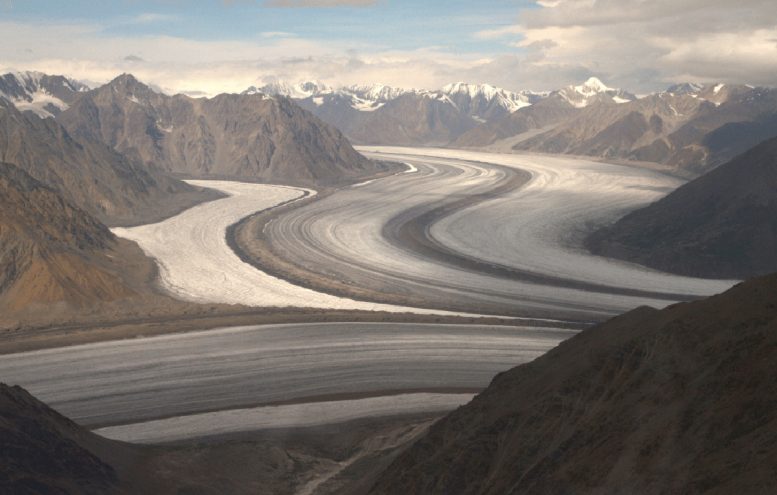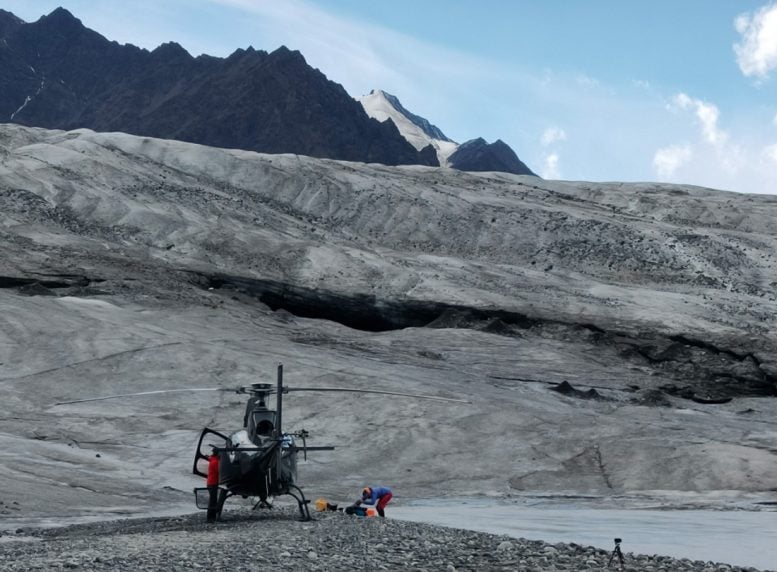
A researcher from the University of Copenhagen found unexpectedly high levels of methane in the meltwater of three Canadian glaciers, challenging existing beliefs about glacial methane emissions. These findings suggest that methane production beneath glaciers is more widespread than previously thought, raising important questions about carbon cycling in glaciated regions and their impact on climate change. Credit: Sarah Elise Sapper
Global warming is unlocking methane reserves, the size of which remains uncertain. A young researcher at the University of Copenhagen found significant amounts of this potent greenhouse gas in meltwater from three Canadian mountain glaciers, previously thought to be methane-free zones. This discovery introduces new uncertainties into our knowledge of methane emissions from the world’s glacier-covered areas.
The helicopter’s rotor blades spin as its skillful pilot performs aerial acrobatics between the steep Yukon mountain sides where PhD student Sarah Elise Sapper is leading her first field expedition deep into the heart of the mountains of northwestern Canada. From the helicopter windows, her eyes fall on the jagged edge of the Donjek glacier: meltwater swirls out from beneath the ice like a whirlpool.
Soon after landing, it becomes apparent that Sarah has stumbled upon an unusual find on the first attempt. Seconds after starting up her portable methane analyzer it is clear that the air is enriched with methane and the culprit is soon found. Collecting a sample of meltwater, she measures concentrations of methane that far exceed expectations.
“We expected to find low values in the meltwater because it is believed that glacial methane emissions require larger ice masses such as vast ice sheets. But the result was quite the opposite. We measured concentrations up to 250 times higher than those in our atmosphere,” explains Sarah Elise Sapper of the University of Copenhagen’s Department of Geosciences and Natural Resource Management.
The field party lifted off and continued to two more mountain glaciers, Kluane and Dusty. And after measuring the methane in the meltwater of each of those two glaciers, the preliminary finding turned out to be more than an anomaly. Here too, measurements showed high methane concentrations. Somewhere beneath the ice, there are previously unknown sources of the gas.
Demonstrates possibility of widespread methane emissions
“The finding is surprising and raises several important questions within this area of research,” says Associate Professor Jesper Riis Christiansen of the Department of Geosciences and Natural Resource Management.
Christiansen, the research article’s co-author, believes that the finding demonstrates the possibility of methane being present beneath many of the world’s glaciers, ones that have thus far been written off.
“When we suddenly see that even mountain glaciers, which are small in comparison with an ice sheet, are able to form and emit methane, it expands our basic understanding of carbon cycling in extreme environments on the planet. The formation and release of methane under ice is more comprehensive and much more widespread than we thought,” he says.

Sarah Elise Sapper directed the helicopter pilot to land close to the glacier edge to measure the methane in whirlpools of meltwater streaming out. Credit: Sarah Elise Sapper
Until now, the prevailing view has been that methane in meltwater could only be found in oxygen-free environments under large masses of ice like the Greenland Ice Sheet.
The researchers assume that the production of methane is biological and happens when an organic carbon source – e.g., deposits from prehistoric marine organisms, soils, peat, or forests – is decomposed by microorganisms in the absence of oxygen, such as we know from wetlands. As such, it is surprising that the mountain glaciers emit methane.
“The meltwater from the surface of glaciers is oxygen-rich when it travels to the bottom of the ice. So we found it quite surprising that all this oxygen is used up somewhere along the way, so that oxygen-free environments form underneath these mountain glaciers. And even more surprising that it happens to such a degree, that microbes start producing methane and we can observe these high methane concentrations in the water flowing out at the glacier edges” states Sarah Elise Sapper.
“Sarah’s findings change our basic understanding and send us back to the drawing board in relation to some of the key mechanisms at play,” adds Jesper Riis Christiansen.
An uncertain role for the climate of the future
According to the researchers, the findings in Canada do not immediately spur an increased concern in relation to their effect on climate change. However, that conclusion may be temporary.
“Methane plays a major role in warming our planet. The challenge with methane is that it is a super-potent greenhouse gas and increasing emissions will accelerate climate warming. From a global perspective, we can measure how much is emitted into the atmosphere and, roughly speaking, where the methane comes from, using the isotopes found in the atmospheric methane. And for now, the contribution of methane from ice-covered regions on our planet, including ice sheets and glaciers, isn’t increasing,” explains Jesper Riis Christiansen.
However, he emphasizes that the measurements cannot distinguish between methane from glaciated regions and methane from wetlands. Therefore, the numbers could be deceiving. And, the effect of melting remains unknown.
Jesper Riis Christiansen believes that the findings demand vigilance.
“The three sites Sarah measured were randomly selected due to the availability of a research station and helicopter, yet methane was found in all three. In itself, that is a good reason to better understand the area. There’s too much that we don’t know, and the melting glaciers expose unknown environments that have remained hidden for thousands of years. In reality, no one knows how emissions will behave,” says Jesper Riis Christiansen.
He hopes that a better understanding of methane behavior beneath glaciers will also help researchers better understand the mechanisms at play when wetlands release methane, and thereby contribute to the development of solutions to remove methane from the atmosphere through oxidation – e.g., through the use of certain soil types.
Reference: “Methane emissions from subglacial meltwater of three alpine glaciers in Yukon, Canada” by Sarah Elise Sapper, Christian Juncher Jørgensen, Moritz Schroll, Frank Keppler and Jesper Riis Christiansen, 12 December 2023, Arctic, Antarctic, and Alpine Research.
DOI: 10.1080/15230430.2023.2284456
>>> Read full article>>>
Copyright for syndicated content belongs to the linked Source : SciTechDaily – https://scitechdaily.com/much-more-widespread-than-we-thought-unexpected-methane-emissions-challenge-climate-change-models/














![[News] Japan Develops 10nm Nanoimprint Technology, with Potential to Tackle EUV Bottleneck – TrendForce](https://earth-news.info/wp-content/uploads/2025/12/329851-news-japan-develops-10nm-nanoimprint-technology-with-potential-to-tackle-euv-bottleneck-trendforce-360x180.jpg)
















